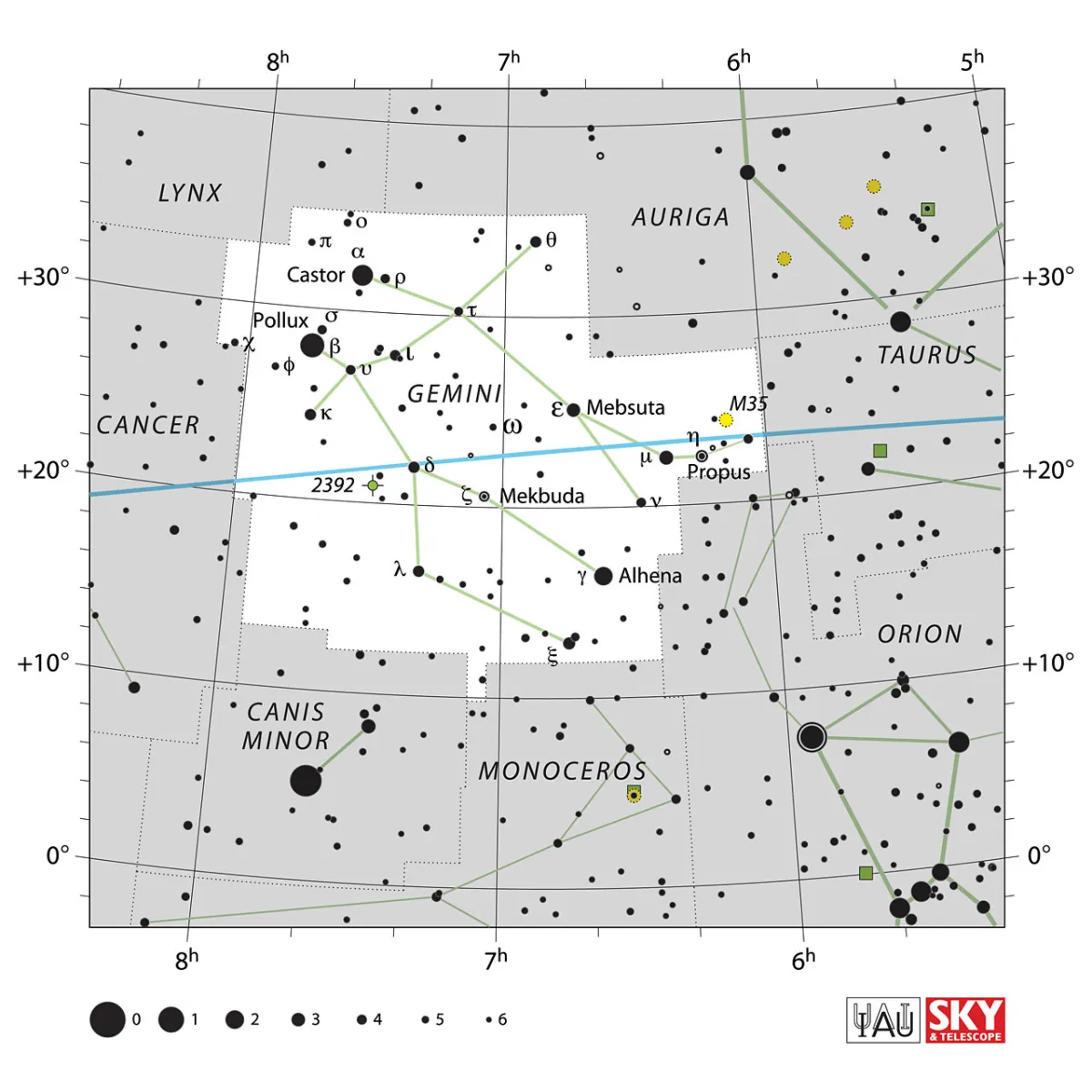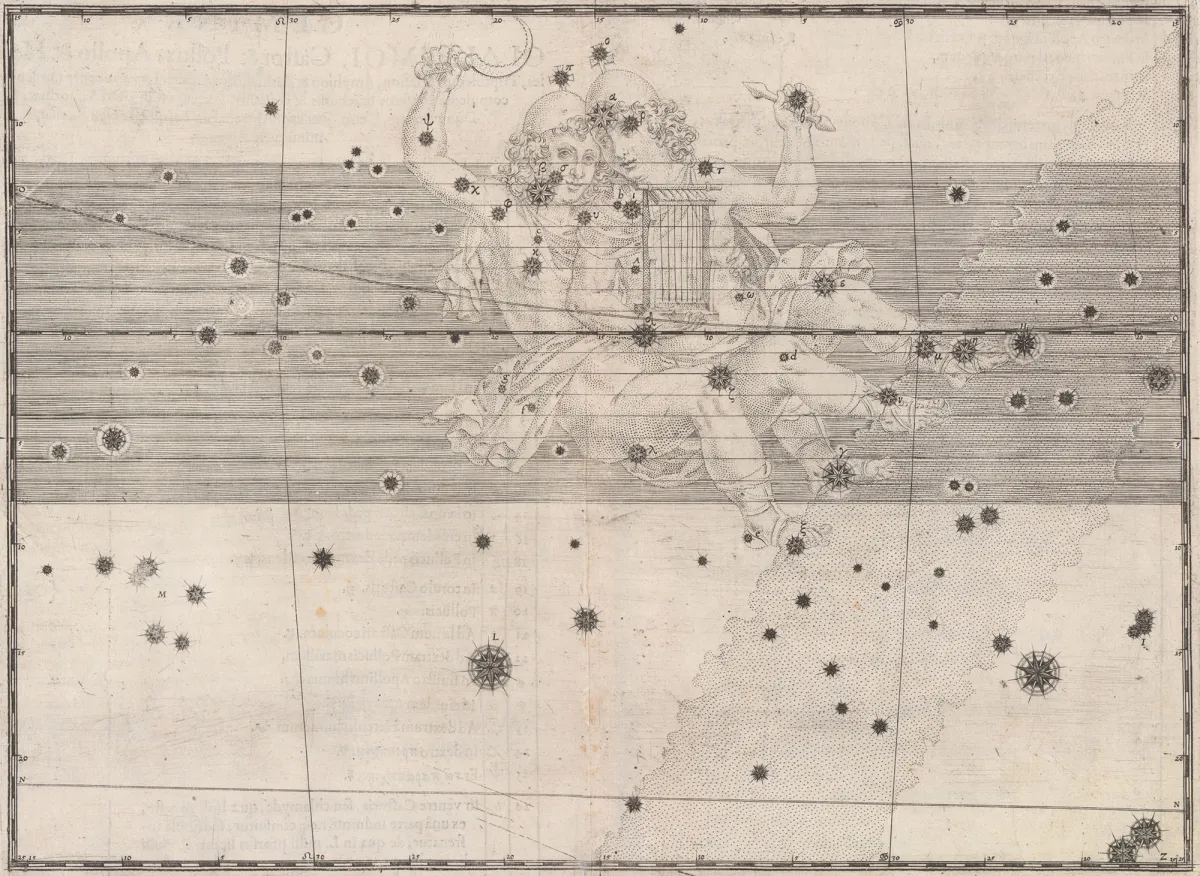Constellation Gemini (Twins)

Properties
The constellation Gemini is located northeast of Orion and has roughly the shape of a long rectangle towards Orion. The two brightest stars Castor (α Geminorum) and Pollux (β Geminorum) are very noticeable. Pollux is the southerly and lighter of the two. The twin stars Castor and Pollux together with Capella (α Aurigae), Aldebaran (α Tauri), Rigel (β Orionis), Sirius (α Canis Majoris) and Procyon (α Canis Minoris) form the winter hexagon. The constellation area is 514 square degrees and the centre culminates around midnight on January 4th. [9, 15]
| α Gem | Castor, Apollo |
| β Gem | Pollux, Hercules |
| γ Gem | Alhena |
| δ Gem | Wasat, Wesat |
| ε Gem | Mebsuta, Melucta, Meboula |
| ζ Gem | Mekbuda |
| η Gem | Propus, Praepes, Tejat Prior |
| ι Gem | Propus |
| μ Gem | Tejat Posterior, Calx, Pish Pai |
| ξ Gem | Alzirr |
| 1 Gem | Propus |
| IAU Name | Gemini |
| IAU Genitive | Geminorum |
| IAU Abbr. | Gem |
| English Name | Twins |
| Culmination at local midnight | 7 January |
| Season (Latitude +0.0°) | September … June |
| Right Ascension (J2000.0) | 06h 00m 30s … 08h 07m 58s |
| Declination (J2000.0) | +09° 48' 35" … +35° 23' 26" |
| Area | 514 deg2 |
| Neighbours (N↻) | Aur, Tau, Ori, Mon, CMi, Cnc, Lyn |
Deep-Sky Object Descriptions
Catalogues
Mythology and History
Castor and Pollux were known as twins in many cultures. Sometimes they were also called The Dioscuri or the sons of Zeus, the king of the gods. Her mother was the beautiful Leda, who appeared to Zeus in the form of a swan. Pollux had an immortal soul; at his death he was granted a home on Mount Olympus. Castor, however, was mortal.

Some said Castor's father was not the mighty Zeus but the earthly king Tyndareus of Sparta. Thus, like the rest of humanity, Castor was destined to be the ultimate resting place of the underworld of Hades. This world of death was not a place of punishment as in the Christian imagination, but a place of incessant indifference and boredom.
Castor excelled in horsemanship, while Pollux excelled in boxing and fighting battles. It was said that the two were as alike as only twins could be. Both married the pretty daughters of a king of Sparta.
A sad day came when a lance pierced Castor's heart during a riot. Pollux understood that his twin brother would now stay in Hades forever. He asked Zeus to send him to the underworld with him. Zeus was not able to grant this request. However, he promised Pollux that he and his brother Castor would spend half of their time on Mount Olympus and the other half in Hades. The two were then given a place under the stars of the firmament.
The Blackfoot Indians used the same star figure to tell of two infants whose mother was killed by a wandering medicine man: The medicine man placed one infant next to the ashes of the fire in the tipi and named it Chief of the Ashes. He put the other behind a buffalo hide and called him the one behind it. The two got magical powers as they grew up to be men. When they died, they went to heaven as twins.
The Chinese associated Castor and Pollux with the two mystical elements of the universe. These stars, it was said, represent yin and yang - the embodiment of opposites in the world: day and night, light and darkness, good and bad. Yin is said to be female while Yang is male. Yin represents the shadow and Yang represents the light. Yin is winter, Yang is summer, and so on. In this philosophy, one element has no meaning without the other. [86]